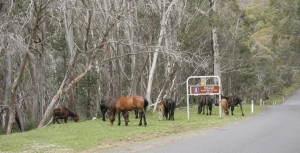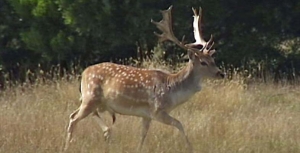Displaying items by tag: feral animals
Wild Horse Heritage Act Condemned
Back in 2016 the NSW government conducted a consultation process on a Wild Horse Management Plan for Kosciuszko National Park (KNP). This was to be part of the Plan of Management for KNP. Based on the assessment of the ecological impact of the horse population its main objective was to reduce the total numbers of wild horses from the estimate of 6,000 down to 3,000 in 5 to 10 years and then to about 600 over a period of 20 years. The implementation of this plan is now impossible following the passing of the Kosciuszko Wild Horse Heritage Act 2018 on 6 June.
Why are Wild Horses a Problem in Alpine Areas?
The government’s website states plainly the reasons why wild horses should be removed:
Scientists have found that feral/wild horses can damage native environments in various ways:
- increasing soil erosion, by killing vegetation, disturbing the soil and creating paths along frequently used routes
- destroying native plants, by grazing and trampling
- fouling waterholes
- collapsing wildlife burrows
- competing with native animals for food and shelter
- spreading weeds, through their dung and hair
Feral/wild horses can also pose a biosecurity risk for spread of disease, as well as pose visitor and public safety risks such as on high speed roads and highways.
Wild horses grazing on the Alpine Way
The website is also frank about the controversy and emotion associated with community attitudes to horses in the national park:
NPWS refers to the horses as 'wild horses' in an effort to maintain balance between environmental and horse advocacy stakeholder groups that regard the terms 'brumby' or 'feral' as either romanticising or being derogatory, depending on the view point.
However it is pointed out that the NPWS:
… has a legal duty to protect native habitats, fauna and flora, geological features and historic and cultural features and values within the park … and has a responsibility to minimise the impacts of introduced species, including those of wild horses.
Key Threatening Process
In April 2018 the NSW Threatened Species Scientific Committee made a preliminary determination proposing that Habitat Degradation and Loss by Feral Horses, Equus caballus be listed as a Key Threatening Process in Schedule 4 of the Biodiversity Conservation Act 2016. Submissions close on 22 June.
As the determination explains:
- alpine and sub-alpine plants are slow-growing, recover slowly from disturbance and often occur in restricted areas;
- soils are fragile and the trampling disturbance caused by horses has negative impacts on a range of species, such as the vulnerable anemone buttercup Ranunculus anemoneus;
- sphagnum bogs (the principal known habitat for the endangered Northern Corroboree Frog, Pseudophryne pengilleyi) have an estimated growth rate of 3.2 to 3.5 cm / 100 years and are extremely sensitive to disturbance and trampling.
Also, many fauna species are sensitive to habitat disturbance and decreased water quality or availability. For example the critically endangered stocky galaxias fish faces extinction from trampling of their habitat.
Whether this determination, when finalised, will have any effect on horse management is now doubtful.
Brief History of Plans to Manage the Wild Horse Population
Since the current 2006 Plan of Management was implemented several reviews have been made of management plans for wild horses. Previous plans of action have proved to be ineffective in making any reduction in wild horse numbers. Trapping using lures and removal – the only method employed during the life of the 2008 Horse Plan – was costly, time consuming and did not effectively reduce the wild horse population. In addition, lack of demand for suitable domesticating (‘rehoming’) opportunities was an impediment. Often the trapped horses were in bad condition and had to be destroyed. The plan provided for aerial mustering but there would have been nowhere to send the horses. Shooting was not part of the plan.
The 2016 Plan of Management provided a comprehensive analysis of different parts of the KNP and defined strategies for a number of management zones to reduce the impact of wild horses. The techniques proposed included:
- mustering, trapping and removal from park for domestication or transport to knackery or abattoir
- trapping and culling on site if transport is not possible
- ground shooting
- fertility control
- fencing
For example the objective for the area south of Mt Kosciuszko towards Dead Horse Gap is to eliminate wild horses within five years while the aim for areas near the Victorian border east of the Alpine Way is to reduce the population as elimination would be impossible. There are other areas where horses are not present and the aim is to prevent them entering the area.
If the population increases there is an increased risk that they will enter more sensitive areas such as the Main Range. Plants in high altitude areas are currently recovering from sheep and cattle grazing that was stopped over 60 years ago.
NSW Government’s New Wild Horse Heritage Act
In a total bolt from the blue on 23 May the leader of the National Party and deputy premier, John Barilaro, presented a bill to the NSW parliament with an objective:
… to recognise the heritage value of sustainable wild horse populations within parts of Kosciuszko National Park and to protect that heritage.
The bill was passed by both houses of parliament on 6 June.
The act is very short on detail. It provides for the preparation of a wild horse heritage management plan for KNP. The draft plan is:
… to identify the heritage value of sustainable wild horse populations within identified parts of the park and set out how that heritage value will be protected while ensuring other environmental values of the park are also maintained.
There is a total conflict of interest here! There is no attempt to define heritage or what a sustainable population means. Do horses have more heritage than native animals? Is it sustainable from the point of view of the horse population only or within the context of the ecology of the whole KNP? The only opportunity for expert input to the draft is from the National Parks Wildlife Advisory Panel but only after the plan has been drafted.
The act will specifically prohibit shooting of wild horses in the national park. It will also limit any other management of wild horses to ‘highly sensitive alpine areas’ and such management will be limited to relocation and rehoming.
The act provides for the establishment of a Community Advisory Panel that will work on the draft plan but it has no requirement for representation by people with scientific qualifications in areas associated with the conservation of nature, nor does it require qualifications in cultural heritage research. It will include alpine tourism and horse riding operators. This arrangement will see scientific advice all but removed from the management of wild horses in KNP.
A major concern is that the act will prevail over the NSW National Parks and Wildlife Act 1974, Section 81(4), and will prevail over the 2006 Kosciuszko National Park Plan of Management, a legal instrument established under that act.
Strong Reaction to the Act
The passing of the act is another example of the NSW government’s disdain for national parks. The horse population will continue to increase. Do they see another tourism opportunity of more people trekking or horse riding in KNP to see wild horses? Perhaps these tourists will be horrified by the sight of starving horses and the damage they are doing as they search for edible grass?
Public condemnation has come from many directions:
- Australian Academy of Science wrote a letter stating the act placed ‘a priority on a single invasive species over many native species and ecosystems, some of which are found nowhere else in the world’
- Scientists from the United Nations body, the International Union for the Conservation of Nature wrote a letter to the environment minister Gabrielle Upton stating that ‘damage to the ecosystem and biodiversity values of the Kosciuszko national park would be detrimental to the reputation and status of Australia and NSW’s record for nature conservation’
- David Watson, an ecology professor at Charles Sturt University, resigned his membership on the NSW Threatened Species Scientific Committee citing the government’s wilful disregard for science
- RSPCA that worked on the 2016 plan as part of the expert panel said the act makes it impossible to conserve the unique environmental values of Kosciuszko as it will veto evidence based management
The only hope is for a change of government at the March 2019 election.
It’s Time to Declare Feral Deer a Pest
In the 19th century deer were imported and released into areas like Royal National Park because they were regarded as useful (for food and sport) and beautiful animals. Now their numbers have exploded.
At the request of the premier, the NSW Natural Resources Commission (NRC) has completed a pest animals management review. They released a draft report early this year and held public hearings around the state and received of over 600 submissions. Its final report and recommendations were submitted to the premier in August. The review found that pest animals cause considerable stress in communities:
It’s hard to measure, but even conservative estimates indicate NSW farmers spend around $22 million to manage pest animals per year, while the total annual economic impact of pest animals in NSW is conservatively estimated to be $170 million. Pest animals also affect 40% of all listed threatened species.
The findings cover pests that have long been causing problems for landholders such as wild dogs, pigs, foxes and rabbits, but they now also recognise that deer are a major cause for concern. For years feral deer have been allowed to run wild in NSW with management aimed at keeping deer numbers high enough to be a game resource. As the report states:
We need to manage the risks and impacts from all invasive species and that means treating feral deer and feral cats as pests just like wild pigs and dogs.
Therefore one recommendation made is that NSW government should:
- exclude all species of deer from the NSW Game and Feral Animal Control Act 2002
- include all species of feral deer in a regulation addressing pest animals under the NSW Biosecurity Act 2015
The Invasive Species Council is concerned that the powerful hunting lobby is determined to maintain the status quo. The Council is calling on people to contact the premier and the Minister for Primary Industries, Niall Blair and support the recommendations of the NRC in order to protect our natural environment from exploding feral deer numbers.
Here is a selection of facts supporting the case for the declaration of feral deer as a pest species. They:
- are out of control throughout NSW
- have been declared by the NRC to be our 'most important emerging pest animal threat'
- are a menace on our roads – in the Illawarra region feral deer have caused nine fatalities in a seven year period and 100 collisions with trains
- can be found in most regions of NSW, threatening the Royal National Park and the Illawarra escarpment rainforests, Kosciuszko National Park, the coastal forests between Newcastle and Coffs Harbour and even woodlands and rangelands in the west
- damage fences, pastures and cropsand can spread weeds and diseases
- impact rainforests and forests
- limit regeneration by reducing seed production and seedling recruitment, heavily browse ferns and other plants and push open the forest understorey
- have already been declared a feral pest in Queensland, SA and WA


